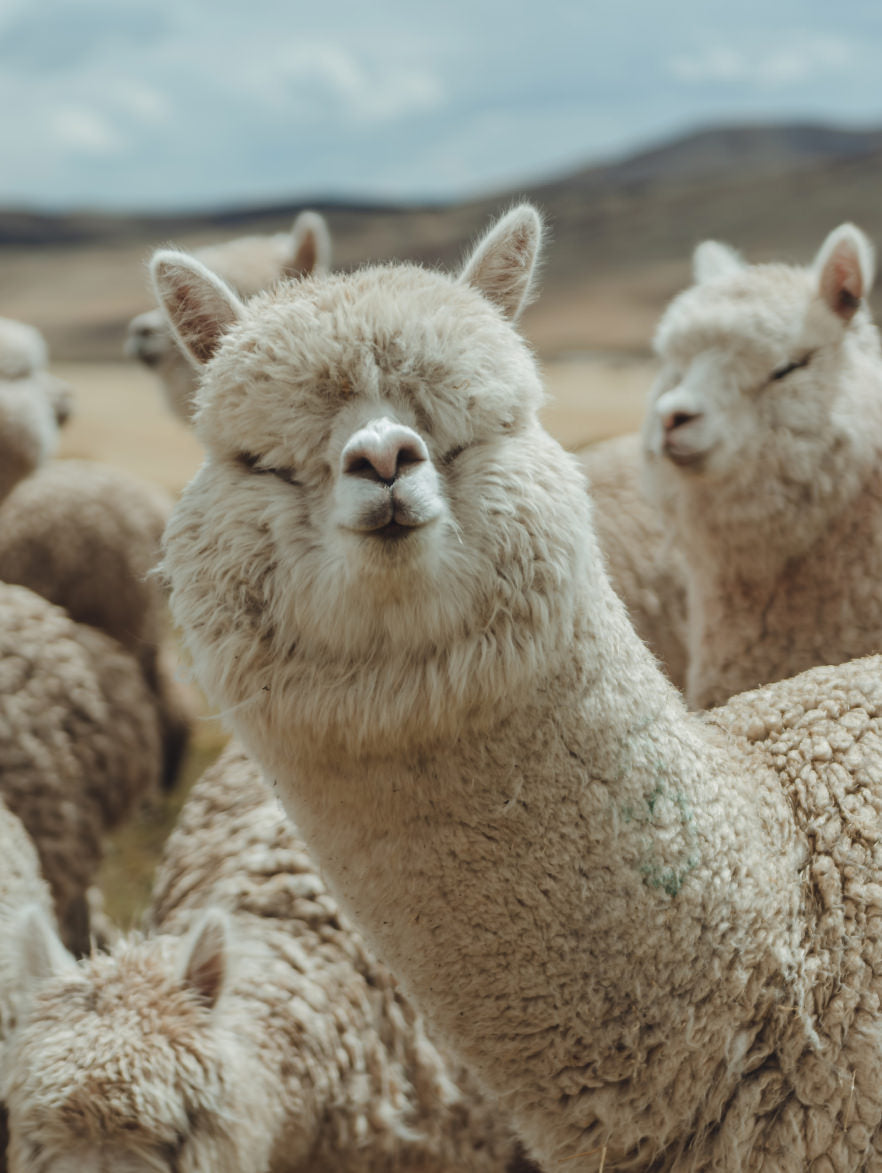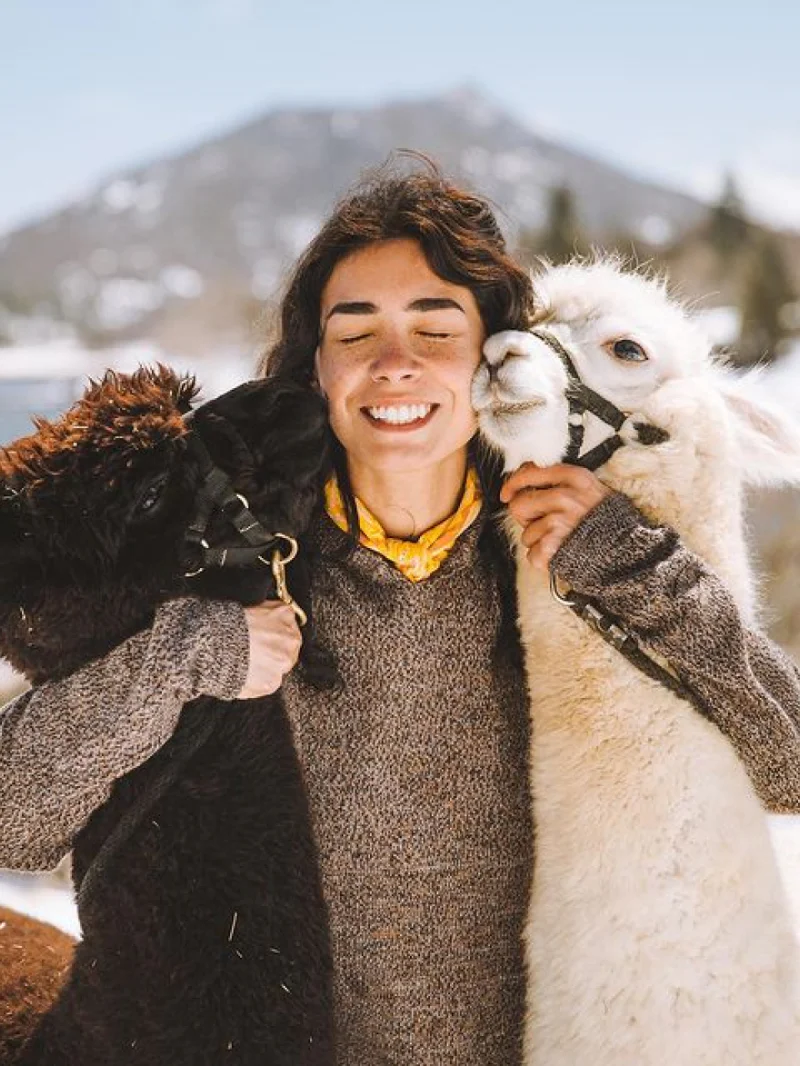



Did you know that there are 86,000 alpaca farms in Peru alone? Or that the average farm has only 60-90 alpacas? Alpacas were domesticated by the pre-Incan civilizations, and have been an irreplaceable piece of the Andes culture for thousands of years. These animals allow the local people to sustain and clothe themselves while supporting economic opportunities.
Alpaca fibers are amongst the softest fibers in the world. While sheep's wool may feel itchy or coarse, alpaca fleece is soft and silky, giving it a cloud-like texture that can be softer than cashmere (depending on the micron diameter). Due its natural coziness, alpaca is one of the most popular fibers to use in blankets and clothing. Once you touch alpaca fiber for the first time, it’s easy to wonder: Where does alpaca fiber come from, how is it sourced, and how do the alpaca farms work?
Since early on in building our brand, we’ve worked closely with the International Alpaca Association
(AIA)
and Daniel Aréstegui. Daniel, manager of AIA and the Peruvian Alpaca Civil Association (ASCALPE,) has dedicated his life to the well-being of alpaca farms. While working on our traceability initiative, Origin, we visited alpaca farms in the Andes. There we spoke with the farmers about their relationships with the land and alpacas.
In this post you’ll find snippets from those conversations. If you’re interested in hearing more from these farmers and Daniel, you can check out our
Origin
page to watch some of the interviews.





Where does alpaca fiber come from?
Alpaca fiber comes from South America, where the animals were likely bred into existence about 6,000 years ago. Even though alpacas are domesticated, they live naturally and roam freely alongside the farmers today. There are two types of alpaca fiber commonly used for textile production: Huacaya and Suri. Huacaya alpacas are commonly referred to as “teddy bear alpacas'' due to the crimp of their fleece. Huacaya alpacas are the most common type of alpaca, accounting for ≈ 95% of all alpacas. Suri alpaca fleece, on the other hand, have smooth long locks that hang down from the alpaca.
A brief history of alpaca farming
The Inca and the alpaca had an incredibly symbiotic relationship. The alpaca provided the main source of income for the Inca people by giving them alpaca fiber, instruments, shoes, medicine, and even fertilizer. The alpaca was so important to the Inca people that it was the chosen gift to the gods. Across the United States, we commonly treat livestock like food, creating a loveless relationship between people and animals. But, in Peru, alpacas are like family.
During the Spanish conquest, Europeans killed the majority of the alpacas, almost driving them into extinction. The remaining few escaped to the Andes Mountains with their alpaqueros, choosing to brace the harsh, high-altitude environment. In order to survive, alpaqueros relied heavily on the warmth of the alpaca, while the alpaca required the help of their owners to stay alive. This dynamic created an even more intimate relationship between the alpaqueros and the alpaca because they needed one another to survive.
During our trip with Daniel, we spoke with Maximilano Mamani, an alpaca breeder, living alongside his alpacas. “The alpaca is everything to us,” he told us, “we exist for it.” Another alpaquero, Albino Sulca, mentioned, “I feel I have a debt to the alpaca, to take care of them.”
Alpacas still roam free in the Andes Mountains. These animals aren’t mass-produced for their fiber. Instead, they live wild, happy lives. While the Peruvian people don’t necessarily rely on the alpaca for their survival anymore, alpaca farming provides crucial economic opportunities. They’re the means through which some families may become educated, and receive access to healthcare. And they do substantially elevate the health and well-being of the local people.
Today, Peru has an estimated 3+ million alpacas, home to approximately 90% of the world’s alpacas. Bolivia has roughly another 500,000 alpacas. The United States and Canada didn’t begin importing their first alpacas until 1984, and some estimates suggest that there are about 50,000 alpacas in the country. But the alpaca still predominantly retains its roots in South America.
In the high Andes, alpacas are raised by more than 86,000 families on small scattered farms.
In Peru, the farmers live in extreme conditions, high in the Andean mountains at 4,000 meters above sea level. Often, the farmers, called alpaqueros, move with the seasons, to ensure their alpacas have access to the most fertile grasses.

How do alpaca farms work?
Breeding on alpaca farms
Some alpaca farms breed babies for a profit. Unlike many mammals, alpacas don’t have a “breeding season,” which means they can exist in a near-constant cycle of breeding. The gestation process lasts about 11 to 12 months. Most female alpacas come of breeding age within two years of their birth. Males may become fertile somewhere between 18 and 36 months. While humans go through hormonal cycles, which limits the ovulation period to a few days, the mating process causes alpacas to ovulate. Some research even shows that if you place a female alpaca outside of a pen where mating is taking place, the act may induce ovulation.
Alpaca Breeding
Alpaca farms generally use two different types of breeding: pasture breeding and managed breeding. Pasture breeding takes place when the farmers pair a male with a group of females in an enclosure. Managed breeding occurs when one male is placed in the same small enclosure as one female. Alpaca farmers often prefer the second breeding method because it makes it easier to time gestation and birth. Both of these methods are usually favored over artificial insemination because artificial insemination doesn’t always trigger ovulation.
Camelids also have a high rate of lost pregnancies – most of which take place in the first month. One way that alpaca farmers may account for lost pregnancies is by building their stock. Realizing an alpaca is pregnant can be a bit tricky. Pregnancies are not typically visible until the last few months of the gestation process because the alpaca fetus is so small. While visiting the farms with Daniel, we saw a baby alpaca born. Witnessing this moment was a reminder for all of us of the fragility and resilience of nature, and the role we have in protecting it.
Breeding Alpacas for Specific Qualities
Many alpaca farmers work with Pacomarca – a sustainable alpaca network that improves breeding practices while boosting the quality of alpaca fiber. While alpaca farmers are generally able to breed for fiber texture, breeding for color can be much more difficult. Some farmers indicate that the pigmentation of the skin may be an indicator for potential color production.
Alpaca farmers who are hoping to produce high-quality fiber should be on the lookout for animals with a low micron count, fiber consistency, density, and length. These are some of the most important qualities that the fiber can have. Alternatively, you may end up with fibers that aren’t uniform, or voluminous. When it comes to alpaca breeding, producing superior fibers is reliant on finding alpacas with quality fiber.
Additionally, if an alpaca farmer wants to produce fiber with a specific smoothness, color, or length, they may work to acquire animals that exhibit the desired features for breeding. While the fiber quality may be partially determined by genetics and the environment, the individual who shears the alpaca also influences the resulting product.
Alpaca farmers may use a variety of tactics to produce their desired breeding results. Some farms rely on random mating. Others might match similar animals. And in some cases, genetic outbreeding can even be beneficial to the farm. This strategy could help to correct defects, or to boost the health of a particular breed.




Shearing on alpaca farms
Most Peruvian alpaca farms are so remote that visitors would have to board two flights, hop on a truck, and ride a horse to get to them. Part of Daniel's mission with AIA is to ensure that these remote farms have access to the highest standards in shearing technology. This ensures the safety of the farmers and the alpacas. Alpaca farms typically shear their animals once a year.
Why are alpacas shorn?
Shearing alpacas on an annual basis is an extremely important and practice to maintain the animal's hygiene, even if farmers are unable to use the fiber for yarn. Failing to do so could contribute to health issues like heat exhaustion, becoming immobilized, susceptible to predation, and developing parasitic infections around the breach. Shearing the alpaca’s entire body helps the animal moderate temperature more effectively during the warm months. If alpaca farmers wait longer than a year to shear their animals, the fiber may become severely matted, which makes it difficult to remove and unlikely to sell.
The fibers that are removed from the alpacas can usually be distributed into production. Most farms that sell fiber don’t actually process it themselves because it’s cost prohibitive. Instead, they sell it to those who intend to turn it into alpaca wool.
Paka Apparel Shearing
Alpaca shearing practices have evolved over time, and they continue to change as alpaca farmers learn more about minimizing alpaca stress and producing quality fiber. We work closely with the Pacomarca network because it combines shearing traditions with 21st-century wisdom to support the health of alpacas and farmers alike. We’re also currently working to provide electric shearing tools for farmers through our partnership with AIA.
Our farmers use the Inca Esquila method for shearing. This method is a mechanized shearing strategy that was developed by Pacomarca to improve fiber yield, while treating animals ethically. Pacomarca offers this service free of charge to alpaca farmers in order to support both the animal and the farmer. This is the method that the Peruvian government adopted as well.




Alpaca fiber sorting is done completely by hand
Most Peruvian alpaca fiber is sent to the city of Arequipa, where it’s washed and sorted prior to production. The sorting of fibers is done completely by hand. Peruvian women separate alpaca fibers into micron ranges (determined by the diameter of the fiber) prior to production. The finer the fiber, the softer and more expensive it is.

Kris (Founder) with Luna's newborn Pacha
Want to start your own alpaca farm?
While alpacas won’t guard your property like llamas, they make great companions and contribute to sustainable farming practices. Alpaca farms exist for both the production of fiber and alpaca breeding.
Alpacas eat mostly hay and grass. They’re very efficient animals (having evolved from camelids), and consume less per month than even a labrador retriever. These animals are also impressive because of their ability to withstand harsh and cold environments. In most cases, alpacas only require a basic 3-walled shelter in which they can weather storms. And alpaca farmers only need about one acre of land for every five alpacas.
A few years ago, our founder Kris adopted two baby alpacas of his own: Luna and Chaska. They are lovingly known as his babies. Both live on a beautiful farm just outside San Diego called A Simpler Time. If you are ever in the area and want to visit, let us know!

Join the herd.
We grant our community private access to new products and exclusive offers.



















